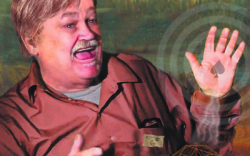Stephanie Calabrese, a UGA-trained artist who lives in nearby Monroe, picked up her iPhone and made a jaw-dropping documentary about her town’s darkest secret: the unsolved 1946 Moore’s Ford Lynching, known as America’s last mass lynching.
So far, Unspoken has won awards at three film festivals, including Best Documentary at the recent Reedy Film Festival in Greenville, S.C.
The documentary was screened on Apr. 13 at UGA’s Jackson Street Building, co-hosted by the Environmental Ethics Certificate Program and Lamar Dodd School of Art. Following the film, NFL Hall of Famer Champ Bailey, a former UGA player, led a conversation with Calabrese and cast members from the documentary.
Another UGA and pro football player, Rennie Curran, led a similar post-film discussion in Monroe on Feb. 19. Although he grew up in Snellville, just 20 miles from Monroe, he had never heard of the incident until he saw Unspoken. The son of Liberian immigrants, Curran says he experienced racism in Snellville but made enduring friendships with white people through sports.
The film deeply affected the people who saw it, says Curran, now a motivational speaker, author and executive coach. “It was definitely very dramatic,” he says. “There was a lot of emotion. You could tell by the body language in the documentary. Some were moved; some were offended, and some didn’t acknowledge their feelings. There is still a lot of trauma, emotion and hurt attached. But we can come together and not just talk about the past but make sure it doesn’t happen again.”
On July 25, 1946, two young black couples—George and Mae Dorsey and Roger and Dorothy Malcolm—were shot to death by a white mob on a dirt road near the Moore’s Ford bridge, between Athens and Monroe. A national outcry followed, and the FBI investigated for four months. No charges were ever filed. Books were written, journalists uncovered new details, lawsuits were filed, but there has been no justice.
Calabrese, a UGA graduate in interdisciplinary studies (fine arts and biological science), moved to Monroe 27 years ago with her former husband and raised two kids there. She still lives just a few blocks from Monroe’s booming downtown restaurant and shopping scene.
A New Jersey native, as a kid she moved with her family to North Augusta, S.C., where she remembered her first blast of racism at 13 when she visited a friend’s home that displayed a Confederate flag and where she heard the family use racial slurs.
Two significant moments spurred Calabrese to make Unspoken.
In 2015, she first focused her lens on Monroe and mounted a photography exhibit that included quotes from interviews she had with Black and white residents. At the exhibit one day, a white woman approached Calabrese with tears in her eyes. The woman was triggered by a quote from a Black man who said that when he was 12, he was happily watching and listening to a practice of the Monroe Drum and Bugle Corps, an all-white girls marching band, until a policeman drove up and ordered him to leave.
“She said, ‘I didn’t know,’” Calabrese recalls.
The second moment came in a 2017 New York Times interview about the photo exhibit, when the reporter asked Calabrese if Monroe still seemed racially segregated.
“I didn’t want to answer it,” she recalls. “I knew the answer was ‘yes,’ but felt a great deal of shame on behalf of our town.”
The documentary took her three and a half years to create. The neverending horror of Unspoken is that, after the murders, every system in America failed utterly in the search for justice, from local law enforcement to the U.S. Supreme Court. The crime happened in the era of segregation in a small town in a state ruled by the racist governor, Eugene Talmadge, when those who likely knew the killers would not come forward. Courts denied the public the right to see grand jury testimony from investigators and locals.
Calabrese is aggressively showing the film at selected venues.
“It took too long for me to build up the courage to dig into our local history in an attempt to better understand the problems we still face today,” she said. “It’s critical to acknowledge and help carry the weight of the wrongs of our past if we ever hope to reconcile with an aim toward community healing. That’s true here in Monroe and in hometowns across the country. I hope the film helps inspire this.”
Like what you just read? Support Flagpole by making a donation today. Every dollar you give helps fund our ongoing mission to provide Athens with quality, independent journalism.










